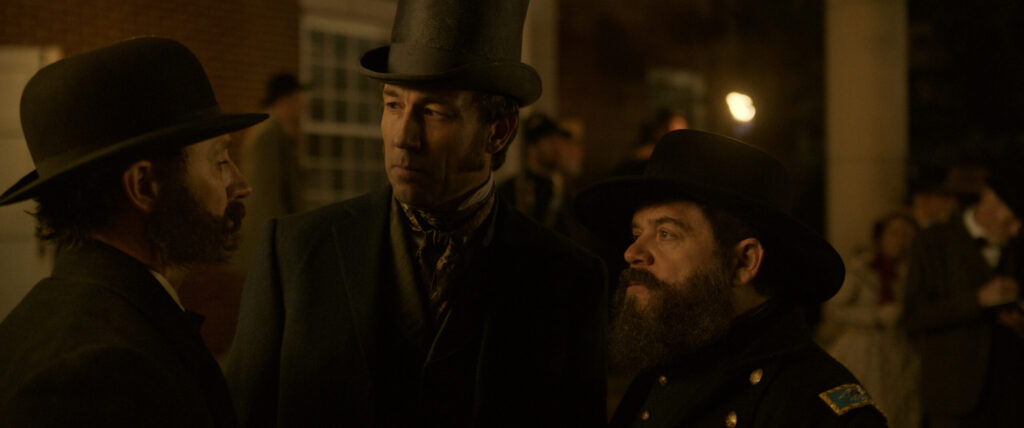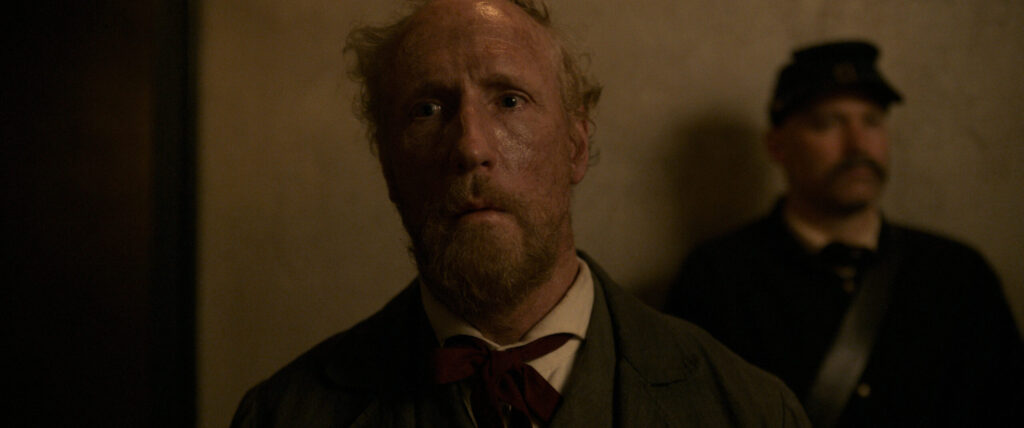“Manhunt,” which is based on the book by John L. Swanson, explores the reasons and consequences behind Lincoln’s murder in great detail. The series conclusion, aptly titled “The Final Act,” brilliantly resolves the intricate narrative threads by bringing to a close unresolved riddles and the political intrigues sparked by this crucial event. Let’s find out how the first season ended.
The Courtroom Drama in Manhunt
The doctor’s reassurance to Mrs. Lincoln in Willie’s chamber on his recovery is sincere but deceptive in the last episode of “Manhunt”. Following her departure, the doctor informs Abe of the terrible news: Willie’s health is critical, and his remaining days may be limited. Unfazed, Abe sticks by Willie’s side and gives him a consoling reading of “Great Expectations” by Charles Dickens.
Soon after, Stanton shows up for Willie with some cold clothes, exposing a rarely-seen side of him. Abe brings up Stanton taking on the position of War Secretary as they exit the room. Stanton tells Abe that he accepts and lays forth his plan. They hope to handle communications during the conflict by taking control of the telegraph system, influencing newspaper coverage, and providing encouraging news to the people.

The trial of the Lincoln conspirators highlights the importance of each character and interaction in the “Manhunt” climax. Stanton’s claim that the trial will reveal the greater plot underlying Booth’s murder highlights how serious the proceedings are. Throughout the trial, Dr. Mudd tries to project a positive image, as demonstrated by his previous quiet generosity to an African American neighbour.
The defence lawyer, Simms, carefully crafts the testimony to counteract prejudicial bias. Persuading his reluctant brother to testify exposes vulnerabilities in himself that bolster Milo’s story of Mudd’s mistreatment, highlighting the significance of human stories in the drama of the courtroom.
The Verdict
Further in “Manhunt,” Simms also convinces Louis Weichmann, whom Stanton had previously distrusted because of his ties to Surratt, to testify against Mudd. The trial becomes more complex as a result of Weichmann’s revelation of a previous relationship with Surratt, which exposes personal stakes and ulterior motives in the testimony.
Although Mudd’s attorney contested Mary’s admission of Mudd’s affiliation with Confederate sympathisers, Weichmann’s frank testimony supports Mary’s admission—despite possible personal consequences. Weichmann’s choice to believe Simms’ account despite their past highlights the veracity of the trial and its influence on people’s lives.

The interaction of these interrelated testimonies ultimately results in Mudd’s conviction. The trial is more than just a court case; it’s a demonstration of the ability to influence justice via the use of strategic storytelling and personal tales.
Conover’s evidence first seems devastating in the dramatic courtroom discoveries of “Manhunt,” when it links the Confederacy to a broad conspiracy to kill important Union individuals. But when the defence reveals Conover’s past deceit and highlights disparities in his testimony, questions are raised.
By demonstrating that Conover was detained at the time he claimed to have witnessed important meetings involving Surratt, Booth, and Sanders, the defence successfully undermines Conover’s essential testimony.
The chief judge personally believed that Jefferson Davis was the mastermind behind Lincoln’s assassination, but there was not enough evidence to indict the Confederate leader. However later in the finale of “Manhunt,” the court’s decisions result in harsh punishments: Edward Spangler will spend the rest of his life in prison, and Mary Surratt, David Herold, Lewis Powell, and George Atzerodt will all get death sentences.
Stanton’s Legacy
Conover’s post-trial disclosure of an enigmatic parcel originating from London, which implies Sanders’s complicity and Conover’s manipulation, contributes further layers to the conspiracy in the finale of “Manhunt”. Equally intriguing is Stanton’s withholding of 18 pages torn from Booth’s diary, suggesting potential links to a failed assassination attempt on Jefferson Davis.
Despite President Johnson’s attempt to remove him from office and the accompanying threats of impeachment, Stanton is unwavering in his dedication to Lincoln’s Reconstruction initiative. During turbulent times, Stanton’s fortitude is strengthened by his steadfast loyalty to Lincoln’s mission.
Stanton defends himself against Johnson’s attempts to remove him from office by barricading himself in the War Office and refusing to bow to political pressure.

Stanton’s persistence shown in “Manhunt” is unfazed by long-term health problems, such as difficulties from asthma. To maintain the ongoing attempts to mend and reconstruct the country following the Civil War, he advocates for the cause of Reconstruction.
Four years after Lincoln’s assassination, Stanton receives news of his Supreme Court confirmation but tragically succumbs to asthma-related organ failure before assuming the position. His son, Eddie Jr., delivers the bittersweet news and later recounts Stanton’s passing due to health complications.
Following Stanton’s death, the 15th Amendment to the US Constitution is ratified, securing voting rights for all citizens regardless of race or past enslavement. Stanton’s unwavering commitment to Lincoln’s Reconstruction efforts endures through these constitutional milestones, underscoring his dedication to completing the work of achieving equality and justice for all.
Also Read: Law & Order: SVU Season 25 Episode 10 Recap: Unveiling Justice
Conclusion
“Manhunt” masterfully intertwines historical events with personal narratives, culminating in a gripping depiction of Lincoln’s legacy and America’s Reconstruction era. The series aptly resolves complex storylines through courtroom drama and political intrigue, showcasing the enduring dedication of figures like Stanton to the cause of justice and equality.
As Stanton’s story unfolds, viewers witness pivotal moments in American history, including the ratification of the 15th Amendment, symbolizing progress towards a more inclusive society shaped by the legacy of Lincoln’s vision.
